The oak bracket mushroom (Pseudoinonotus dryadeus) is a huge, often prolific grower appearing on oak trees. It stands out with a wildly lumpy cap and considerable size. This wood-decay fungus can grow up to 16 inches wide! Oak bracket mushrooms also exude amber droplets when they’re young, which makes them look a bit freakish. This mushroom is widespread in North America but is largely absent in the Rocky Mountains and the Great Plains.
- Scientific Name: Pseudoinonotus dryadeus, formerly Inonotus dryadeus
- Common Names: Oak Bracket, Weeping Polypore, Weeping Conk, Warted Oak Polypore
- Habitat: On oak trees and a few other hardwoods
- Edibility: Inedible
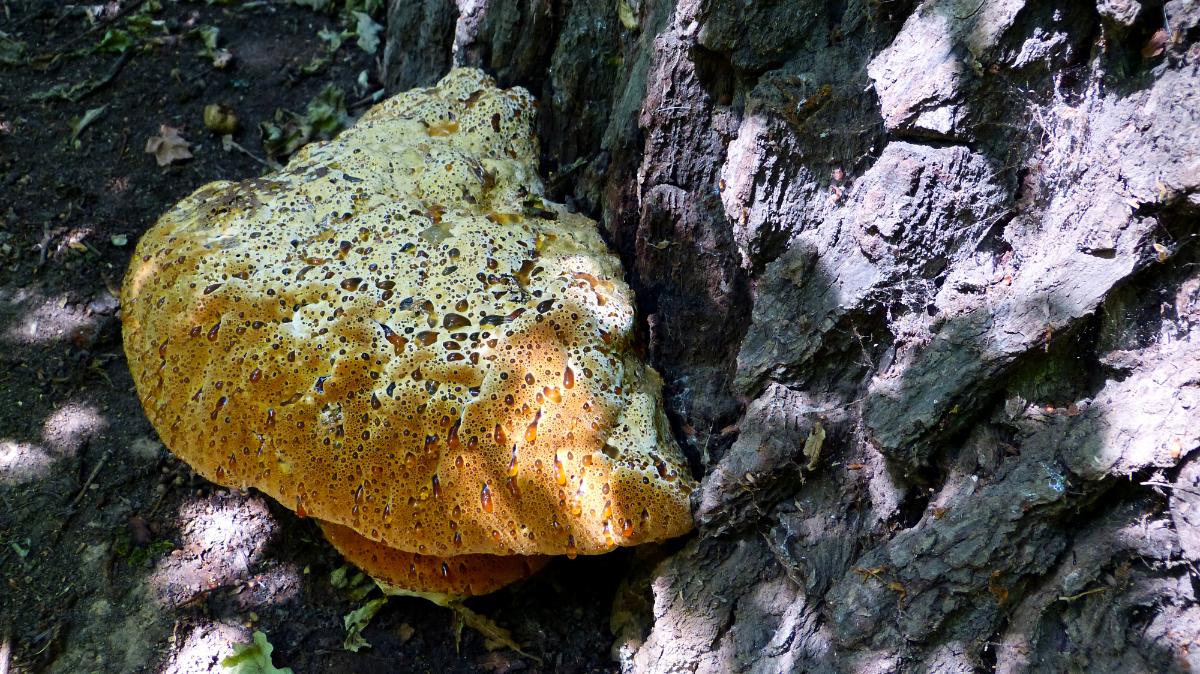
Jump to:
All About Oak Bracket Mushrooms
These mushrooms grow as thick, shelf-like growths near the base of trees. The oak bracket can grow up to 16 inches across! One of its most distinctive features is the amber-colored liquid that oozes from its surface.
The oak bracket mushroom was originally named Boletus dryadeus in 1799. It was later known as Inonotus dryadeus. In 2001, scientists gave it its current name, Pseudoinonotus dryadeus. The name itself tells a story – “pseudo” means false, “ino” means fibrous, “ot” means ear, and “dryadeus” refers to its connection with oak trees. This roughly translates to false fibrous ear that looks like Inonotus and grows on oak trees.
The oak bracket serves a crucial ecological role. It is both a parasite and decomposer, entering trees through wounds and primarily affecting their roots. The fungus causes white rot in the base of trunks. When you see the fruiting bodies, it often indicates that the fungus has already established itself within the tree’s root system.
For many people, finding this mushroom on an oak tree is not a good thing. The oak bracket mushroom starts rotting the roots of the tree first. And, usually, by the time you see the brackets growing, it is too late to save the tree.

Oak Bracket Mushroom Identification
Season
Oak brackets appear from late summer through early winter. The fruiting bodies are quite persistent. They can stick around for several years, though they’ll turn black and develop cracks as they age.
Habitat
In eastern North America, this species grows on oak trees. While they strongly prefer oaks, they occasionally grow on other hardwoods like maple, elm, and chestnut. On the West Coast, they grow on fir trees.
They usually appear either individually or in small, overlapping clusters near the tree’s base, close to the ground. As the white rot spreads through the tree, the fruiting bodies may show up on roots away from the tree trunk.
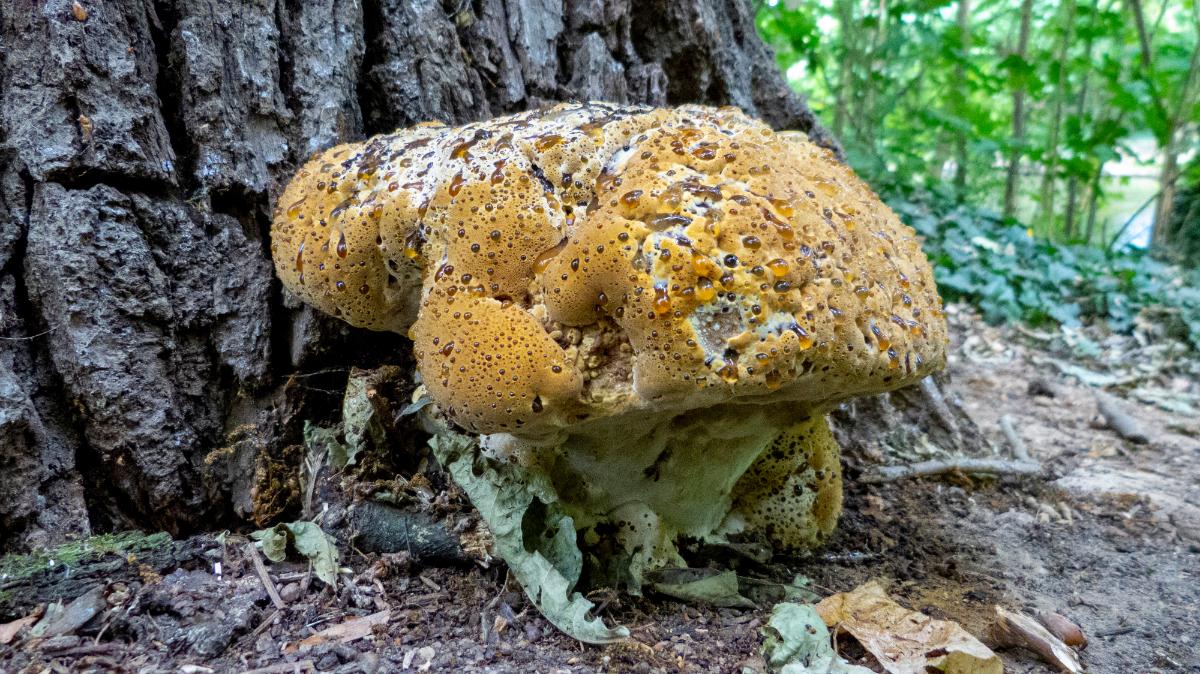
Identification
Cap
The most striking feature is the cap, which can grow anywhere from 2 to 16 inches wide (though some giants reach up to 30 inches!). Its velvety surface starts cream-colored and develops into a rusty brown shade with a distinctive yellow margin. An amber liquid oozes from small pits on the surface when the mushroom is young. The liquid is most common around the edges of the cap. It looks just like honey, though we definitely don’t recommend tasting it.
The cap is irregularly semicircular. It looks like an overstuffed cushion attached to the side of a tree. The flesh is very thick, even in young specimens. With age, the velvety surface wears off, and the cap becomes bald.
Pores
The pores start out grayish-white and mature into yellow or ochre shades. They bruise slowly brown when handled. Pores often also exude droplets of amber liquid when the mushroom is young.
Stem
Oak brackets don’t have a stem. They grow directly from the tree in a bracket or shelf-like formation.
Taste and Smell
These mushrooms have a slightly acidic flavor. The smell can be quite unpleasant, especially in older specimens.
Flesh Color and Staining
The flesh is thick and fibrous. It is somewhat soft when young. With age, it turns corky and leathery. It is yellowish-brown and can reach up to 4 inches in thickness. The flesh shows distinct color zones and darkens to reddish brown with age.
Spore Print
The spore print is white.




Oak Bracket Mushroom Lookalikes
Oak Polypore (Buglossoporus quercinus, syn. Piptoporous quercinus)
The oak polypore and the oak bracket are both wood-decay fungi that primarily grow on oak trees. However, they have distinct characteristics that set them apart.
The oak polypore is a rare species, typically found on veteran oak trees in old-growth forests. It produces annual fruiting bodies that are bracket-shaped, soft, and spongy when fresh. These fruiting bodies are usually pale cream to buff in color, sometimes with a pinkish tinge. They are only known from the Northeast of the US.
The primary difference is color and shape. The oak bracket is lumpy and multi-colored with patches of white, yellowish-brown, and brown. It also releases the amber droplets, which the oak polypore never does.

Black Staining Polypore (Meripilus sumstinei)
This polypore also grows at the base of oak trees, like the oak bracket. However, it has several distinct characteristics that set it apart.
The black-staining polypore, also known as the giant polypore, is known for its massive size. It can grow up to 3 feet across and weigh up to 100 pounds (the largest one recorded was 200 lbs!). This species grows as clusters of overlapping, fan-shaped brackets that are dark brown to black in color. The flesh is white and has a rubbery texture when fresh. And, the pores stain black when handled, which is a great indicator for the species.
The oak bracket has a more rounded, kidney-shaped appearance. It is usually found growing singly or in small groups rather than in large clusters. The giant polypore, while capable of growing on various hardwoods, is not as strongly associated with a single tree species.
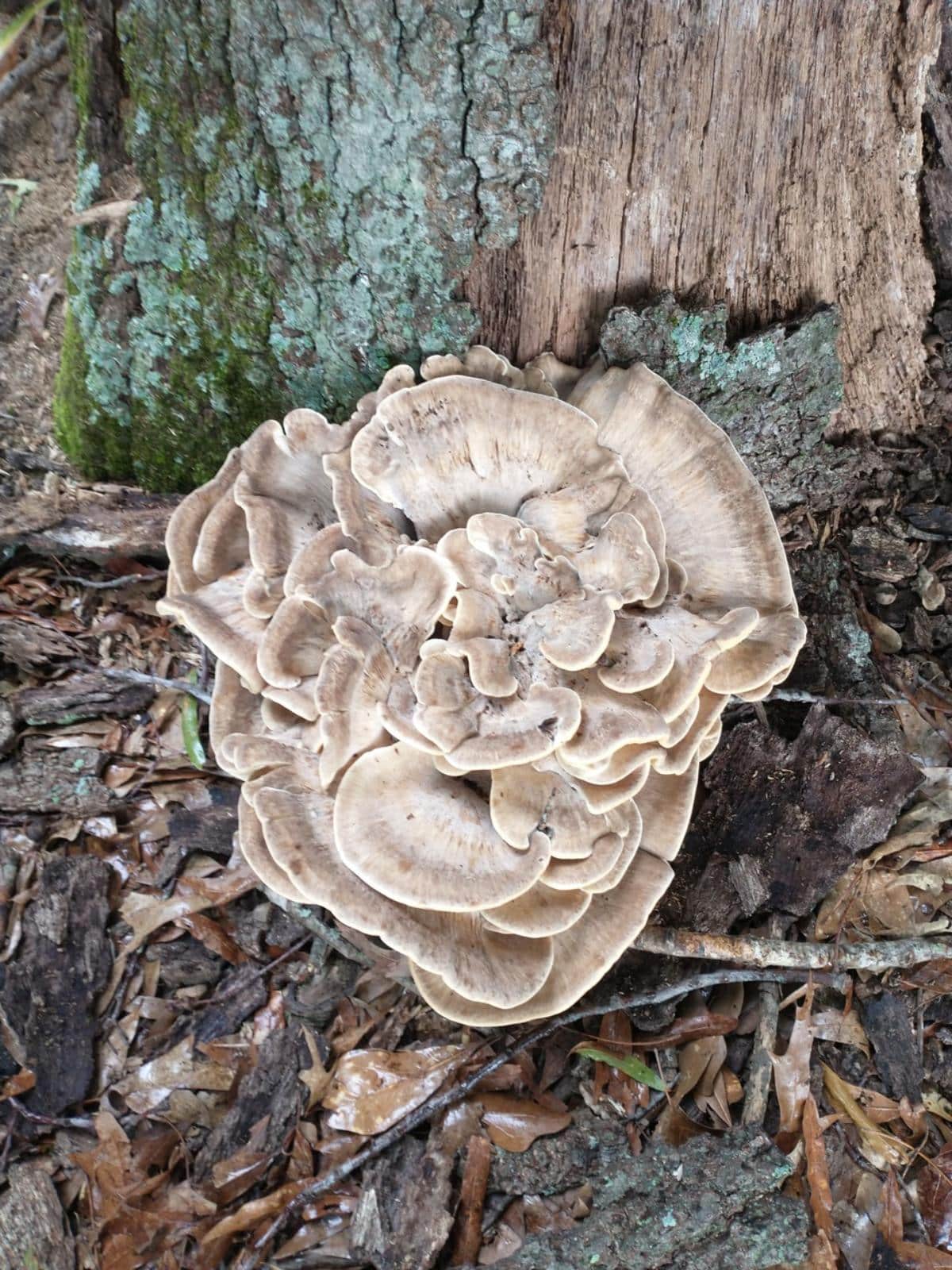
Beefsteak Fungus (Fistulina hepatica)
The beefsteak fungus and the oak bracket are both wood-decay fungi commonly found on oak trees. As its name suggests, the beefsteak fungus has a striking resemblance to raw meat. It has a soft texture similar to the oak bracket and also oozes small droplets when young. There are a few key differences. The beefsteak is reddish to brownish in color, and the liquid it emits is also reddish to brownish. Beefsteak mushrooms also bleed red liquid when the flesh is cut.
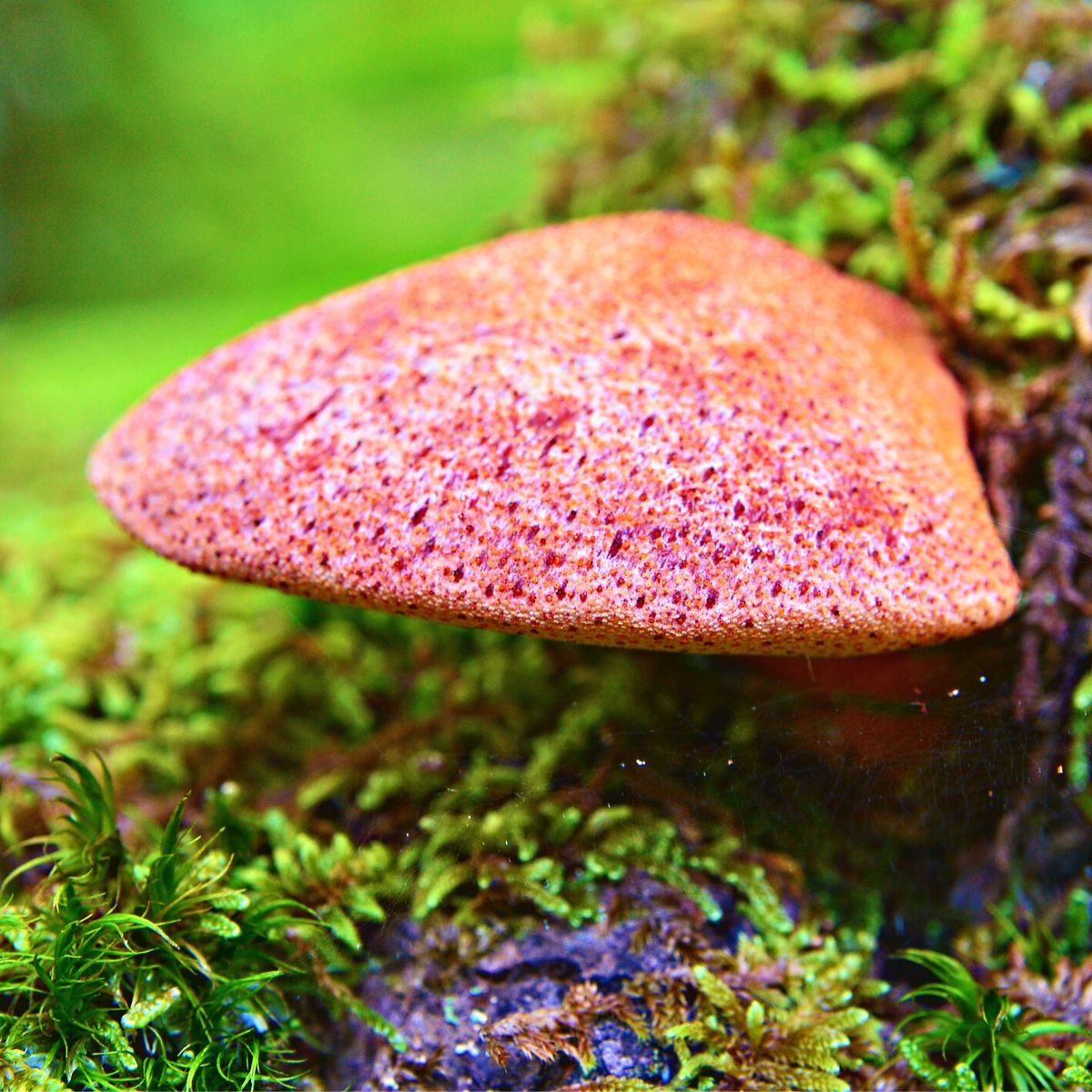
Oak Bracket Mushroom Edibility
This fungus is inedible. It’s actually just as tough and bitter as the bark of the trees it grows on. The taste is notably unpleasant. It has a distinctly acidic and sour profile.

Oak Bracket Mushroom Removal (Landscape Management)
This parasitic fungus can seriously impact landscape trees. It grows on living trees and causes severe root rot. Infected trees might fall before you even notice any signs. Trees can appear perfectly healthy on the outside, while devastating root decay silently destroys their foundation. This often leads to unexpected collapse during storms. Trees can die abruptly during extreme heat conditions, often as a result of previously damaged root systems.
Most commonly, infected trees show a gradual decline, such as stunted growth, dying branches, and thinning, discolored foliage. These symptoms may worsen when environmental conditions become challenging.
Since no fungicide treatments are available yet, prevention is the best option. If you spot conks on trees, get them checked by your local tree expert right away. The good news is that the fungus has not been observed to jump to nearby oak trees. Trees infected are solitary, and tree-to-tree spread has not been reported. Severely damaged trees may need removal. Healthy trees have better chances of staying infection-free.

Common Questions About Oak Bracket Mushrooms
Are oak bracket mushrooms safe to eat?
Oak bracket mushrooms are not edible. They have a tough, woody texture and an unpleasant, bitter taste.
How can I identify an oak bracket mushroom?
Look for large, shelf-like growths at the base of oak trees, typically 2-12 inches wide. They have a velvety surface that starts cream-colored and turns rusty brown with a yellow margin. A key identifier is the amber liquid that oozes from small pits on the surface, resembling honey.
Should I remove oak bracket fungi from my trees?
While removing the visible fruiting bodies can prevent spore release, it won’t eliminate the underlying infection. These mushrooms typically attack older or weakened trees. It’s best to consult with a professional arborist to assess the tree’s overall health and determine the best course of action.
Are oak bracket fungi harmful to trees?
Oak bracket fungi can cause decay in the heartwood of trees. This will potentially weaken them over time. And, it may lead to structural issues in affected trees.

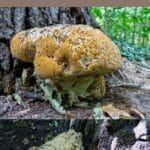







Leave a Reply